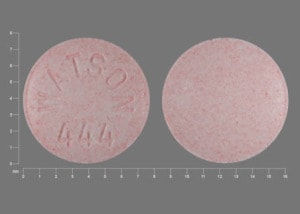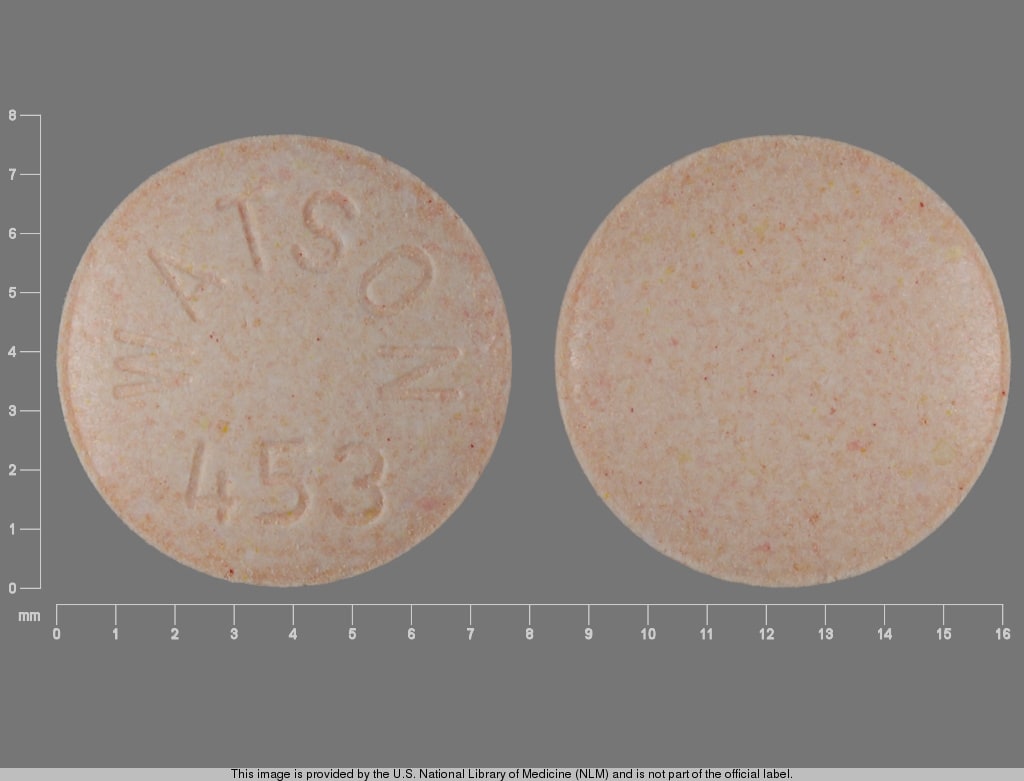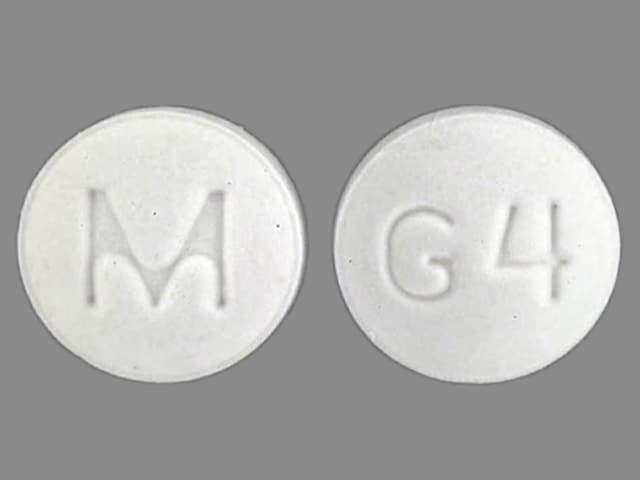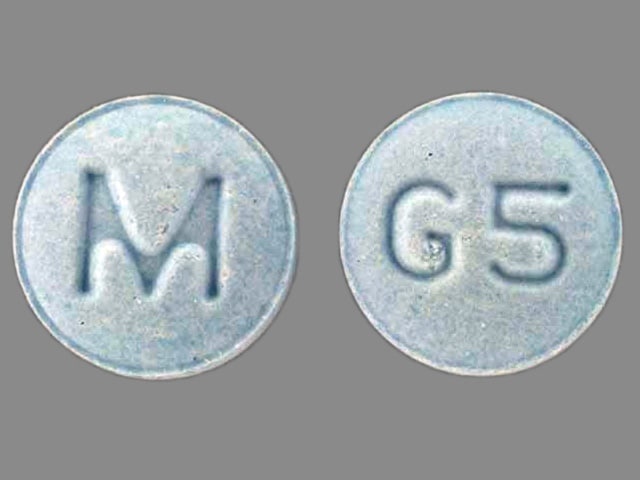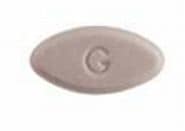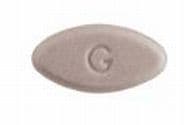Dosage Forms
Excipient information presented when available (limited, particularly for generics); consult specific product labeling. [DSC] = Discontinued product
Tablet, Oral:
Tenex: 1 mg [DSC] [contains fd&c red #40 aluminum lake]
Tenex: 2 mg [DSC] [contains fd&c yellow #10 aluminum lake]
Generic: 1 mg, 2 mg
Tablet Extended Release 24 Hour, Oral:
Intuniv: 1 mg, 2 mg, 3 mg, 4 mg
Generic: 1 mg, 2 mg, 3 mg, 4 mg
Pharmacology
Mechanism of Action
Guanfacine is a selective alpha2A-adrenoreceptor agonist that reduces sympathetic nerve impulses, resulting in reduced sympathetic outflow and a subsequent decrease in vasomotor tone and heart rate. In addition, guanfacine preferentially binds postsynaptic alpha2A-adrenoreceptors in the prefrontal cortex and has been theorized to improve delay-related firing of prefrontal cortex neurons. As a result, underlying working memory and behavioral inhibition are affected; thereby improving symptoms associated with ADHD. Guanfacine is not a CNS stimulant.
Pharmacokinetics/Pharmacodynamics
Absorption
Readily absorbed.
Distribution
Vd: Immediate release: 6.3 L/kg; Extended release: Vd (apparent): Children ≥6 years: 23.7 L/kg; Adolescent: 19.9 L/kg (Boellner 2007)
Metabolism
Hepatic via CYP3A4. Approximately 50% of clearance is hepatic.
Excretion
Urine (~50% [40% to 75% of dose] as unchanged drug)
Time to Peak
Serum:
Immediate release: 2.6 hours (range: 1 to 4 hours)
Extended release: Children ≥6 years and Adolescents: 5 hours (Boellner 2007); Adults: 4 to 8 hours
Duration of Action
Antihypertensive effect: 24 hours following single dose
Half-Life Elimination
Immediate release: ~17 hours (range: 10 to 30 hours)
Extended release: Children ≥6 years: 14.4 hours; Adolescents: 18 hours (Boellner 2007); Adults: 18 ± 4 hours
Protein Binding
~70%
Use in Specific Populations
Special Populations: Renal Function Impairment
In patients with renal impairment, clearance is reduced; plasma levels are only slightly increased. In patients on hemodialysis, dialysis clearance was ~15% of total clearance.
Special Populations: Children
Exposure to guanfacine was higher in children (6 to 12 years of age) compared with adolescents (13 to 17 years of age).
Use: Labeled Indications
Attention-deficit/hyperactivity disorder (extended release only): Treatment of attention-deficit/hyperactivity disorder (ADHD) as monotherapy and as adjunctive therapy to stimulant medications.
Hypertension (immediate release only): Management of hypertension. Note: Not recommended for the initial treatment of hypertension (ACC/AHA [Whelton 2017]).
Contraindications
Hypersensitivity to guanfacine or any component of the formulation
Dosage and Administration
Dosing: Adult
Hypertension (alternative agent): Immediate release: Oral: Initial: 0.5 to 1 mg once daily at bedtime; may increase as needed after 3 to 4 weeks up to 2 mg once daily at bedtime (ACC/AHA [Whelton 2017]). Note: Adverse reactions increase significantly with doses above 3 mg/day.
Dosing: Geriatric
Immediate release: Refer to adult dosing. In the management of hypertension, consider lower initial doses and titrate to response (Aronow 2011).
Dosing: Pediatric
Note: Immediate release and extended release products are not interchangeable on a mg-per-mg basis due to differences in pharmacokinetic profiles.
Attention-deficit/hyperactivity disorder:
Immediate-release product: Limited data available (Dopheide 2009; Pliszka 2007):
Children ≥6 years and Adolescents:
≤45 kg: Oral: Initial: 0.5 mg once daily at bedtime; may titrate every 3 to 4 days in 0.5 mg/day increments to 0.5 mg twice daily, then 0.5 mg three times daily, then 0.5 mg four times daily; maximum daily dose: Patient weight 27 to 40.5 kg: 2 mg/day; 40.5 to 45 kg: 3 mg/day.
>45 kg: Oral: Initial: 1 mg once daily at bedtime; may titrate every 3 to 4 days in 1 mg/day increments to 1 mg twice daily, then 1 mg three times daily, then 1 mg four times daily; maximum daily dose: 4 mg/day.
Extended release product (eg, Intuniv): Children and Adolescents 6 to 17 years: Oral: Initial: 1 mg once daily administered at the same time of day (in the morning or evening); may titrate dose by no more than 1 mg/week increments based upon response and as tolerated to the recommended target dose range: 0.05 to 0.12 mg/kg/day or 1 to 7 mg/day. Target range based on data from monotherapy trials to balance the exposure (dose)-related potential benefits and risks (hypotension, bradycardia, and sedative effects). In clinical monotherapy trials, initial clinical response was associated with doses of 0.05 to 0.08 mg/kg once daily; increased efficacy was seen with increasing mg/kg doses; doses up to 0.12 mg/kg once daily have shown benefit when tolerated. In adjunctive therapy trials with stimulant medication, doses of 0.05 to 0.12 mg/kg/day produced optimal clinical response in the majority of patients.
Suggested fixed target dose range for patients weighing ≥ 25 kg: All doses administered once daily at the same time (either in the morning or evening) not to exceed age-based maximum daily doses.
25 to 33.9 kg: 2 to 3 mg/day.
34 to 41.4 kg: 2 to 4 mg/day.
41.5 to 49.4 kg: 3 to 5 mg/day.
49.5 to 58.4 kg: 3 to 6 mg/day.
58.5 to 91 kg: 4 to 7 mg/day.
>91 kg: 5 to 7 mg/day.
Maximum daily doses: Doses above the following have not been evaluated.
Monotherapy: Children 6 to 12 years: 4 mg/day; Adolescents: 13 to 17 years: 7 mg/day.
Adjunct therapy (with psychostimulants): 4 mg/day.
Conversion from immediate release guanfacine to the extended release product: Discontinue the immediate release product; initiate the extended release product at the doses recommended above.
Missed doses of extended release: If patient misses two or more consecutive doses, repeat titration of dose should be considered.
Discontinuation of extended release: Taper dose by no more than 1 mg every 3 to 7 days.
Dosing adjustment for concomitant CYP3A4 inhibitors/inducers with extended release:
Strong CYP3A4 inhibitors: If initiating guanfacine while taking a strong 3A4 inhibitor, decrease guanfacine dose to 50% the recommended target dose . If continuing guanfacine and adding a strong CYP3A4 inhibitor, decrease guanfacine dose by 50% the recommended target dose. If the strong CYP3A4 inhibitor is discontinued, increase guanfacine to the recommended target dose.
Strong CYP3A4 inducers: If initiating guanfacine while taking a strong CYP3A4 inducer, consider increasing dose up to double the recommended target dose. If continuing guanfacine and adding a strong CYP3A4 inducer, consider increasing guanfacine dose up to double the recommended target dose over 1 to 2 weeks. If the strong CYP3A4 inducer is discontinued, decrease guanfacine dose to recommended target dose over 1 to 2 weeks.
Hypertension: Children ≥12 years and Adolescents: Immediate release product: Oral: 1 mg usually at bedtime; may increase, if needed, at 3- to 4-week intervals; usual range: 0.5 to 2 mg/day; maximum daily dose: 2 mg/day.
Pervasive developmental disorders (PDD) and ADHD: Limited data available; efficacy results variable:
Children and Adolescents 5 to 14 years: Immediate release product:
<25 kg: Oral: Initial: 0.25 mg once daily, increase dose as tolerated every 4 days in 0.25 mg/day increments in 2 to 3 divided doses; maximum daily dose: 3 mg/day (Scahill 2006).
≥25 kg: Oral: Initial: 0.5 mg once daily, increase dose as tolerated every 4 days in 0.5 mg/day increments in 2 to 3 divided doses; maximum daily dose: 3 mg/day (Handen 2008; Scahill 2006).
Dosing based on a double-blind, placebo-controlled, 6-week crossover trial conducted in children with ADHD and autism or intellectual disabilities (n=11; age: 5 to 9 years); five of 11 patients showed improvement in hyperactivity scores; other patient assessment parameters did not show improvements (Handen, 2008). In an open-label 8-week pilot study in children with ADHD and PDD (n=25; mean age: 9 years; range: 5-14 years), patients showed improvement in parent- and teacher-rated hyperactivity subscale scores; increased irritability occurred in seven patients; the authors note that patients with PDD may be more sensitive to irritability-type adverse effects (Scahill 2006). A retrospective chart review of pediatric autism spectrum disorders (n=80; age: 3 to 18 years) reported ~24% of patients responded to mean dose of 2.6 mg/day; the authors noted patients with Asperger’s or PDD not otherwise specified (NOS) responded more frequently than those with autistic disorder or comorbidity of mental retardation (Posey 2004).
Tic disorder; Tourette syndrome: Limited data available; greater efficacy shown in patients with ADHD comorbidity (Murphy [AACAP 2013], Pringsheim 2012; Roessner [ESSTS 2011]; Weisman 2013):
Children and Adolescents 6 to 16 years: Immediate release product: Oral: Initial: 0.5 mg once daily at bedtime for 3 days, then 0.5 mg twice daily for 4 days, then 0.5 mg 3 times daily for 7 days; further upward titration based on clinical response to maximum daily dose: 4 mg/day (Scahill 2001); twice daily dosing may be effective for some patients (Chappell 1995, Cummings 2002). Dosing based on a double-blind, placebo-controlled study in patients with ADHD and mild to moderate tics (n=34; mean age: 10.4 years; range: 7 to 14 years); reported final dose range: 1.5 to 3 mg/day in 3 divided doses with the most common dose reported was 2.5 mg/day (ie, 1 mg in morning, 0.5 mg at 3 pm, and 1 mg at bedtime); a statistically significant decrease (31%) in tic scores and improvement in teacher-rated ADHD scores was reported after 8 weeks (Scahill 2001). A small open-label trial of patients with Tourette’s syndrome and ADHD (n=10; age range: 8 to 16 years) used similar initial doses and dose titration (0.5 mg increments every 3 to 4 days); final reported dose range: 0.75 to 3 mg/day in divided doses (2 to 3 times daily); seven of 10 patients required a final dose of 1.5 mg/day in divided doses (Chappell 1995). A short 4-week trial evaluating 24 patients (age range: 6 to 16 years) with mild chronic tic disorder showed only slight improvement in tic scores after titration (over approximately 3 weeks) to a final dose of 2 mg/day (Cummings 2002).
Administration
Oral: Immediate-release tablets are usually given at bedtime to minimize somnolence. Formulations (immediate release versus extended release) are not interchangeable.
Dietary Considerations
Extended-release tablets: Do not administer with a high-fat meal due to increased exposure.
Storage
Immediate release: Store at 20°C to 25°C (68°F to 77°F).
Extended release: Store at 20°C to 25°C (68°F to 77°F); excursions permitted between 15°C and 30°C (59°F and 86°F).
GuanFACINE Images
Drug Interactions
Alcohol (Ethyl): May enhance the CNS depressant effect of GuanFACINE. Avoid combination
Alfuzosin: May enhance the hypotensive effect of Blood Pressure Lowering Agents. Monitor therapy
Alizapride: May enhance the CNS depressant effect of CNS Depressants. Monitor therapy
Amifostine: Blood Pressure Lowering Agents may enhance the hypotensive effect of Amifostine. Management: When amifostine is used at chemotherapy doses, blood pressure lowering medications should be withheld for 24 hours prior to amifostine administration. If blood pressure lowering therapy cannot be withheld, amifostine should not be administered. Consider therapy modification
Amphetamines: May diminish the antihypertensive effect of Antihypertensive Agents. Monitor therapy
Antipsychotic Agents (Second Generation [Atypical]): Blood Pressure Lowering Agents may enhance the hypotensive effect of Antipsychotic Agents (Second Generation [Atypical]). Monitor therapy
Azelastine (Nasal): CNS Depressants may enhance the CNS depressant effect of Azelastine (Nasal). Avoid combination
Barbiturates: May enhance the hypotensive effect of Blood Pressure Lowering Agents. Monitor therapy
Benperidol: May enhance the hypotensive effect of Blood Pressure Lowering Agents. Monitor therapy
Beta-Blockers: Alpha2-Agonists may enhance the AV-blocking effect of Beta-Blockers. Sinus node dysfunction may also be enhanced. Beta-Blockers may enhance the rebound hypertensive effect of Alpha2-Agonists. This effect can occur when the Alpha2-Agonist is abruptly withdrawn. Management: Closely monitor heart rate during treatment with a beta blocker and clonidine. Withdraw beta blockers several days before clonidine withdrawal when possible, and monitor blood pressure closely. Recommendations for other alpha2-agonists are unavailable. Exceptions: Levobunolol; Metipranolol. Consider therapy modification
Blonanserin: CNS Depressants may enhance the CNS depressant effect of Blonanserin. Consider therapy modification
Bradycardia-Causing Agents: May enhance the bradycardic effect of other Bradycardia-Causing Agents. Monitor therapy
Brexanolone: CNS Depressants may enhance the CNS depressant effect of Brexanolone. Monitor therapy
Brigatinib: May diminish the antihypertensive effect of Antihypertensive Agents. Brigatinib may enhance the bradycardic effect of Antihypertensive Agents. Monitor therapy
Brimonidine (Topical): May enhance the CNS depressant effect of CNS Depressants. Monitor therapy
Brimonidine (Topical): May enhance the hypotensive effect of Blood Pressure Lowering Agents. Monitor therapy
Bromopride: May enhance the CNS depressant effect of CNS Depressants. Monitor therapy
Bromperidol: Blood Pressure Lowering Agents may enhance the hypotensive effect of Bromperidol. Bromperidol may diminish the hypotensive effect of Blood Pressure Lowering Agents. Avoid combination
Bromperidol: May enhance the CNS depressant effect of CNS Depressants. Avoid combination
Buprenorphine: CNS Depressants may enhance the CNS depressant effect of Buprenorphine. Management: Consider reduced doses of other CNS depressants, and avoiding such drugs in patients at high risk of buprenorphine overuse/self-injection. Initiate buprenorphine at lower doses in patients already receiving CNS depressants. Consider therapy modification
Cannabidiol: May enhance the CNS depressant effect of CNS Depressants. Monitor therapy
Cannabis: May enhance the CNS depressant effect of CNS Depressants. Monitor therapy
Ceritinib: Bradycardia-Causing Agents may enhance the bradycardic effect of Ceritinib. Management: If this combination cannot be avoided, monitor patients for evidence of symptomatic bradycardia, and closely monitor blood pressure and heart rate during therapy. Exceptions are discussed in separate monographs. Consider therapy modification
Chlormethiazole: May enhance the CNS depressant effect of CNS Depressants. Management: Monitor closely for evidence of excessive CNS depression. The chlormethiazole labeling states that an appropriately reduced dose should be used if such a combination must be used. Consider therapy modification
Chlorphenesin Carbamate: May enhance the adverse/toxic effect of CNS Depressants. Monitor therapy
Clofazimine: May increase the serum concentration of CYP3A4 Substrates (High risk with Inhibitors). Monitor therapy
CNS Depressants: May enhance the adverse/toxic effect of other CNS Depressants. Monitor therapy
Conivaptan: May increase the serum concentration of CYP3A4 Substrates (High risk with Inhibitors). Avoid combination
CYP3A4 Inducers (Moderate): May decrease the serum concentration of GuanFACINE. Management: Increase the guanfacine dose by up to double when initiating guanfacine in a patient taking a moderate CYP3A4 inducer. Increase guanfacine dose gradually over 1 to 2 weeks if initiating a moderate CYP3A4 inducer in a patient already taking guanfacine. Consider therapy modification
CYP3A4 Inducers (Strong): May decrease the serum concentration of GuanFACINE. Management: Increase the guanfacine dose by up to double when initiating guanfacine in a patient taking a strong CYP3A4 inducer. Increase guanfacine dose gradually over 1 to 2 weeks if initiating strong CYP3A4 inducer therapy in a patient already taking guanfacine. Consider therapy modification
CYP3A4 Inhibitors (Moderate): May increase the serum concentration of GuanFACINE. Management: Reduce the guanfacine dose by 50% when initiating this combination. Consider therapy modification
CYP3A4 Inhibitors (Strong): May increase the serum concentration of GuanFACINE. Management: Reduce the guanfacine dose by 50% when initiating this combination. Consider therapy modification
Dabrafenib: May decrease the serum concentration of CYP3A4 Substrates (High risk with Inducers). Management: Seek alternatives to the CYP3A4 substrate when possible. If concomitant therapy cannot be avoided, monitor clinical effects of the substrate closely (particularly therapeutic effects). Consider therapy modification
Deferasirox: May decrease the serum concentration of CYP3A4 Substrates (High risk with Inducers). Monitor therapy
Dexmethylphenidate: May diminish the therapeutic effect of Antihypertensive Agents. Monitor therapy
Diazoxide: May enhance the hypotensive effect of Blood Pressure Lowering Agents. Monitor therapy
Dimethindene (Topical): May enhance the CNS depressant effect of CNS Depressants. Monitor therapy
Doxylamine: May enhance the CNS depressant effect of CNS Depressants. Management: The manufacturer of Diclegis (doxylamine/pyridoxine), intended for use in pregnancy, specifically states that use with other CNS depressants is not recommended. Monitor therapy
Dronabinol: May enhance the CNS depressant effect of CNS Depressants. Monitor therapy
Droperidol: May enhance the CNS depressant effect of CNS Depressants. Management: Consider dose reductions of droperidol or of other CNS agents (eg, opioids, barbiturates) with concomitant use. Exceptions to this monograph are discussed in further detail in separate drug interaction monographs. Consider therapy modification
DULoxetine: Blood Pressure Lowering Agents may enhance the hypotensive effect of DULoxetine. Monitor therapy
Enzalutamide: May decrease the serum concentration of CYP3A4 Substrates (High risk with Inducers). Management: Concurrent use of enzalutamide with CYP3A4 substrates that have a narrow therapeutic index should be avoided. Use of enzalutamide and any other CYP3A4 substrate should be performed with caution and close monitoring. Consider therapy modification
Erdafitinib: May decrease the serum concentration of CYP3A4 Substrates (High risk with Inducers). Monitor therapy
Erdafitinib: May increase the serum concentration of CYP3A4 Substrates (High risk with Inhibitors). Monitor therapy
Esketamine: May enhance the CNS depressant effect of CNS Depressants. Monitor therapy
Fexinidazole [INT]: Bradycardia-Causing Agents may enhance the arrhythmogenic effect of Fexinidazole [INT]. Avoid combination
Flunitrazepam: CNS Depressants may enhance the CNS depressant effect of Flunitrazepam. Consider therapy modification
Fosaprepitant: May increase the serum concentration of CYP3A4 Substrates (High risk with Inhibitors). Monitor therapy
Fusidic Acid (Systemic): May increase the serum concentration of CYP3A4 Substrates (High risk with Inhibitors). Avoid combination
Herbs (Hypertensive Properties): May diminish the antihypertensive effect of Antihypertensive Agents. Monitor therapy
Herbs (Hypotensive Properties): May enhance the hypotensive effect of Blood Pressure Lowering Agents. Monitor therapy
HYDROcodone: CNS Depressants may enhance the CNS depressant effect of HYDROcodone. Management: Avoid concomitant use of hydrocodone and benzodiazepines or other CNS depressants when possible. These agents should only be combined if alternative treatment options are inadequate. If combined, limit the dosages and duration of each drug. Consider therapy modification
HydrOXYzine: May enhance the CNS depressant effect of CNS Depressants. Monitor therapy
Hypotension-Associated Agents: Blood Pressure Lowering Agents may enhance the hypotensive effect of Hypotension-Associated Agents. Monitor therapy
Idelalisib: May increase the serum concentration of CYP3A4 Substrates (High risk with Inhibitors). Avoid combination
Ivabradine: Bradycardia-Causing Agents may enhance the bradycardic effect of Ivabradine. Monitor therapy
Ivosidenib: May decrease the serum concentration of CYP3A4 Substrates (High risk with Inducers). Monitor therapy
Kava Kava: May enhance the adverse/toxic effect of CNS Depressants. Monitor therapy
Lacosamide: Bradycardia-Causing Agents may enhance the AV-blocking effect of Lacosamide. Monitor therapy
Larotrectinib: May increase the serum concentration of CYP3A4 Substrates (High risk with Inhibitors). Monitor therapy
Lemborexant: May enhance the CNS depressant effect of CNS Depressants. Management: Dosage adjustments of lemborexant and of concomitant CNS depressants may be necessary when administered together because of potentially additive CNS depressant effects. Close monitoring for CNS depressant effects is necessary. Consider therapy modification
Levodopa-Containing Products: Blood Pressure Lowering Agents may enhance the hypotensive effect of Levodopa-Containing Products. Monitor therapy
Lofexidine: May enhance the CNS depressant effect of CNS Depressants. Management: Drugs listed as exceptions to this monograph are discussed in further detail in separate drug interaction monographs. Monitor therapy
Lorlatinib: May decrease the serum concentration of CYP3A4 Substrates (High risk with Inducers). Management: Avoid concurrent use of lorlatinib with any CYP3A4 substrates for which a minimal decrease in serum concentrations of the CYP3A4 substrate could lead to therapeutic failure and serious clinical consequences. Consider therapy modification
Lormetazepam: May enhance the hypotensive effect of Blood Pressure Lowering Agents. Monitor therapy
Magnesium Sulfate: May enhance the CNS depressant effect of CNS Depressants. Monitor therapy
Methotrimeprazine: CNS Depressants may enhance the CNS depressant effect of Methotrimeprazine. Methotrimeprazine may enhance the CNS depressant effect of CNS Depressants. Management: Reduce adult dose of CNS depressant agents by 50% with initiation of concomitant methotrimeprazine therapy. Further CNS depressant dosage adjustments should be initiated only after clinically effective methotrimeprazine dose is established. Consider therapy modification
Methylphenidate: May diminish the antihypertensive effect of Antihypertensive Agents. Monitor therapy
MetyroSINE: CNS Depressants may enhance the sedative effect of MetyroSINE. Monitor therapy
Midodrine: May enhance the bradycardic effect of Bradycardia-Causing Agents. Monitor therapy
MiFEPRIStone: May increase the serum concentration of CYP3A4 Substrates (High risk with Inhibitors). Management: Minimize doses of CYP3A4 substrates, and monitor for increased concentrations/toxicity, during and 2 weeks following treatment with mifepristone. Avoid cyclosporine, dihydroergotamine, ergotamine, fentanyl, pimozide, quinidine, sirolimus, and tacrolimus. Consider therapy modification
Minocycline (Systemic): May enhance the CNS depressant effect of CNS Depressants. Monitor therapy
Mirtazapine: May diminish the antihypertensive effect of Alpha2-Agonists. Management: Consider avoiding concurrent use. If the combination cannot be avoided, monitor for decreased effects of alpha2-agonists if mirtazapine is initiated/dose increased, or increased effects if mirtazapine is discontinued/dose decreased. Consider therapy modification
Mitotane: May decrease the serum concentration of CYP3A4 Substrates (High risk with Inducers). Management: Doses of CYP3A4 substrates may need to be adjusted substantially when used in patients being treated with mitotane. Consider therapy modification
Molsidomine: May enhance the hypotensive effect of Blood Pressure Lowering Agents. Monitor therapy
Nabilone: May enhance the CNS depressant effect of CNS Depressants. Monitor therapy
Naftopidil: May enhance the hypotensive effect of Blood Pressure Lowering Agents. Monitor therapy
Nicergoline: May enhance the hypotensive effect of Blood Pressure Lowering Agents. Monitor therapy
Nicorandil: May enhance the hypotensive effect of Blood Pressure Lowering Agents. Monitor therapy
Nitroprusside: Blood Pressure Lowering Agents may enhance the hypotensive effect of Nitroprusside. Monitor therapy
Obinutuzumab: May enhance the hypotensive effect of Blood Pressure Lowering Agents. Management: Consider temporarily withholding blood pressure lowering medications beginning 12 hours prior to obinutuzumab infusion and continuing until 1 hour after the end of the infusion. Consider therapy modification
Opioid Agonists: CNS Depressants may enhance the CNS depressant effect of Opioid Agonists. Management: Avoid concomitant use of opioid agonists and benzodiazepines or other CNS depressants when possible. These agents should only be combined if alternative treatment options are inadequate. If combined, limit the dosages and duration of each drug. Consider therapy modification
Orphenadrine: CNS Depressants may enhance the CNS depressant effect of Orphenadrine. Avoid combination
Oxomemazine: May enhance the CNS depressant effect of CNS Depressants. Avoid combination
OxyCODONE: CNS Depressants may enhance the CNS depressant effect of OxyCODONE. Management: Avoid concomitant use of oxycodone and benzodiazepines or other CNS depressants when possible. These agents should only be combined if alternative treatment options are inadequate. If combined, limit the dosages and duration of each drug. Consider therapy modification
Palbociclib: May increase the serum concentration of CYP3A4 Substrates (High risk with Inhibitors). Monitor therapy
Paraldehyde: CNS Depressants may enhance the CNS depressant effect of Paraldehyde. Avoid combination
Pentoxifylline: May enhance the hypotensive effect of Blood Pressure Lowering Agents. Monitor therapy
Perampanel: May enhance the CNS depressant effect of CNS Depressants. Management: Patients taking perampanel with any other drug that has CNS depressant activities should avoid complex and high-risk activities, particularly those such as driving that require alertness and coordination, until they have experience using the combination. Consider therapy modification
Pholcodine: Blood Pressure Lowering Agents may enhance the hypotensive effect of Pholcodine. Monitor therapy
Phosphodiesterase 5 Inhibitors: May enhance the hypotensive effect of Blood Pressure Lowering Agents. Monitor therapy
Piribedil: CNS Depressants may enhance the CNS depressant effect of Piribedil. Monitor therapy
Pramipexole: CNS Depressants may enhance the sedative effect of Pramipexole. Monitor therapy
Prostacyclin Analogues: May enhance the hypotensive effect of Blood Pressure Lowering Agents. Monitor therapy
Quinagolide: May enhance the hypotensive effect of Blood Pressure Lowering Agents. Monitor therapy
ROPINIRole: CNS Depressants may enhance the sedative effect of ROPINIRole. Monitor therapy
Rotigotine: CNS Depressants may enhance the sedative effect of Rotigotine. Monitor therapy
Rufinamide: May enhance the adverse/toxic effect of CNS Depressants. Specifically, sleepiness and dizziness may be enhanced. Monitor therapy
Ruxolitinib: May enhance the bradycardic effect of Bradycardia-Causing Agents. Management: Ruxolitinib Canadian product labeling recommends avoiding use with bradycardia-causing agents to the extent possible. Monitor therapy
Sarilumab: May decrease the serum concentration of CYP3A4 Substrates (High risk with Inducers). Monitor therapy
Selective Serotonin Reuptake Inhibitors: CNS Depressants may enhance the adverse/toxic effect of Selective Serotonin Reuptake Inhibitors. Specifically, the risk of psychomotor impairment may be enhanced. Monitor therapy
Serotonin/Norepinephrine Reuptake Inhibitors: May diminish the antihypertensive effect of Alpha2-Agonists. Monitor therapy
Siltuximab: May decrease the serum concentration of CYP3A4 Substrates (High risk with Inducers). Monitor therapy
Simeprevir: May increase the serum concentration of CYP3A4 Substrates (High risk with Inhibitors). Monitor therapy
Siponimod: Bradycardia-Causing Agents may enhance the bradycardic effect of Siponimod. Management: Avoid coadministration of siponimod with drugs that may cause bradycardia. Consider therapy modification
Sodium Oxybate: May enhance the CNS depressant effect of CNS Depressants. Management: Consider alternatives to combined use. When combined use is needed, consider minimizing doses of one or more drugs. Use of sodium oxybate with alcohol or sedative hypnotics is contraindicated. Consider therapy modification
Stiripentol: May increase the serum concentration of CYP3A4 Substrates (High risk with Inhibitors). Management: Use of stiripentol with CYP3A4 substrates that are considered to have a narrow therapeutic index should be avoided due to the increased risk for adverse effects and toxicity. Any CYP3A4 substrate used with stiripentol requires closer monitoring. Consider therapy modification
Suvorexant: CNS Depressants may enhance the CNS depressant effect of Suvorexant. Management: Dose reduction of suvorexant and/or any other CNS depressant may be necessary. Use of suvorexant with alcohol is not recommended, and the use of suvorexant with any other drug to treat insomnia is not recommended. Consider therapy modification
Tapentadol: May enhance the CNS depressant effect of CNS Depressants. Management: Avoid concomitant use of tapentadol and benzodiazepines or other CNS depressants when possible. These agents should only be combined if alternative treatment options are inadequate. If combined, limit the dosages and duration of each drug. Consider therapy modification
Terlipressin: May enhance the bradycardic effect of Bradycardia-Causing Agents. Monitor therapy
Tetrahydrocannabinol: May enhance the CNS depressant effect of CNS Depressants. Monitor therapy
Tetrahydrocannabinol and Cannabidiol: May enhance the CNS depressant effect of CNS Depressants. Monitor therapy
Thalidomide: CNS Depressants may enhance the CNS depressant effect of Thalidomide. Avoid combination
Tocilizumab: May decrease the serum concentration of CYP3A4 Substrates (High risk with Inducers). Monitor therapy
Tofacitinib: May enhance the bradycardic effect of Bradycardia-Causing Agents. Monitor therapy
Tricyclic Antidepressants: May diminish the antihypertensive effect of Alpha2-Agonists. Management: Consider avoiding this combination. If used, monitor for decreased effects of the alpha2-agonist. Exercise great caution if discontinuing an alpha2-agonist in a patient receiving a TCA. Consider therapy modification
Trimeprazine: May enhance the CNS depressant effect of CNS Depressants. Monitor therapy
Valproate Products: GuanFACINE may increase the serum concentration of Valproate Products. Monitor therapy
Yohimbine: May diminish the antihypertensive effect of Antihypertensive Agents. Monitor therapy
Zolpidem: CNS Depressants may enhance the CNS depressant effect of Zolpidem. Management: Reduce the Intermezzo brand sublingual zolpidem adult dose to 1.75 mg for men who are also receiving other CNS depressants. No such dose change is recommended for women. Avoid use with other CNS depressants at bedtime; avoid use with alcohol. Consider therapy modification
Test Interactions
May lead to false-positive aldosterone/renin ratio (ARR) (Funder 2016).
Adverse Reactions
Adverse events occurred with children and adolescents 6 to 17 years of age unless otherwise specified.
>10%:
Central nervous system: Drowsiness (28% to 57%), headache (16% to 28%), fatigue (10% to 22%), dizziness (4% to 16%), insomnia (2% to 13%)
Gastrointestinal: Abdominal pain (8% to 19%), decreased appetite (5% to 15%)
1% to 10%:
Cardiovascular: Hypotension (4% to 9%), bradycardia (2% to 5%), orthostatic hypotension (1% to 5%), first-degree atrioventricular block (≥2%), sinus arrhythmia (≥2%), tachycardia (≥2%), syncope (1% to ≥2%)
Central nervous system: Irritability (5% to 8%), lethargy (3% to 8%), anxiety (2% to 5%), nightmares (3% to 4%), emotional lability (2% to 3%), agitation (≥2%), depression (≥2%), increased blood pressure (≥2%), loss of consciousness (children: ≥2%)
Dermatologic: Skin rash (2% to 3%), pruritus (2%)
Endocrine & metabolic: Weight gain (2% to 3%)
Gastrointestinal: Xerostomia (3% to 8%), nausea (5% to 7%), vomiting (2% to 7%), diarrhea (2% to 6%), constipation (2% to 4%), abdominal distress (≥2%), dyspepsia (≥2%), stomach discomfort (≥2%)
Genitourinary: Urinary incontinence (2% to 5%)
Respiratory: Asthma (≥2%)
Miscellaneous: Fever (8%; Biederman 2008)
Frequency not defined:
Cardiovascular: Atrioventricular block, chest pain, hypertension
Central nervous system: Seizure
Dermatologic: Pallor
Genitourinary: Urinary frequency
Hepatic: Increased serum ALT
Hypersensitivity: Hypersensitivity reaction
Neuromuscular & skeletal: Weakness
<1%, postmarketing, and/or case reports: Alopecia, arthralgia, blurred vision, confusion, dermatitis, dysgeusia, dyspnea, edema, erectile dysfunction, exfoliative dermatitis, hallucination, hypertensive encephalopathy (with abrupt discontinuation), leg cramps, leg pain, malaise, myalgia, palpitations, paresthesia, rebound hypertension (with abrupt discontinuation), sedation, tremor, vertigo
Warnings/Precautions
Concerns related to adverse effects:
- Cardiovascular effects: May cause atrioventricular (AV) block, bradycardia, hypotension, orthostasis, sinus node dysfunction, and syncope; these effects are dose-dependent, more pronounced during the first month of therapy, or may worsen especially when used with other sympatholytic drugs. Monitor vital signs frequently in patients with cardiac conduction abnormalities or those concomitantly treated with other sympatholytic drugs.
- CNS effects: May cause sedation and drowsiness which may impair physical or mental abilities; patients must be cautioned about performing tasks that require mental alertness (eg, operating machinery, driving).
- Dermatological effects: Skin rash with exfoliation and pruritus have been reported; discontinue guanfacine and monitor patients who develop a rash.
Disease-related concerns:
- Cardiovascular disease: Use with caution in patients with severe coronary insufficiency, recent MI, or a history of bradycardia, cardiovascular disease, heart block, hypotension, or syncope. Cautious use is also recommended in patients with conditions that predispose them to syncope (eg, orthostasis, dehydration).
- Cerebrovascular disease: Use with caution in patients with cerebrovascular disease.
- Hepatic impairment: Use with caution in patients with chronic hepatic impairment. Dosage adjustment may be necessary in severe impairment.
- Renal impairment: Use with caution in patients with chronic renal impairment. Dosage adjustment may be necessary in severe impairment.
Concurrent drug therapy issues:
- Drug-drug interactions: Potentially significant interactions may exist, requiring dose or frequency adjustment, additional monitoring, and/or selection of alternative therapy. Consult drug interactions database for more detailed information.
Dosage form specific issues:
- Product interchangeability: Formulations of guanfacine (immediate release versus extended release) are not interchangeable on a mg to mg basis because bioavailability, Cmax, and Tmax vary.
Other warnings/precautions:
- Discontinuation of therapy: Increased heart rate and rebound hypertension have been reported with abrupt discontinuation; hypertensive encephalopathy has also been reported. Increased risk of rebound hypertension may occur in children with GI illnesses and vomiting. Concomitant stimulant use may increase blood pressure if guanfacine is abruptly stopped. To minimize these effects, taper the dose in decrements of ≤1 mg every 3 to 7 days and monitor blood pressure and pulse following dosage reduction/discontinuation.
- ADHD treatment: Appropriate use: Recommended to be used as part of a comprehensive treatment program for attention-deficit disorders; safety and efficacy of long-term use for the treatment of ADHD (>2 years) have not been established (Sallee 2009).
Monitoring Parameters
Heart rate, blood pressure
ADHD: Thoroughly evaluate for cardiovascular risk. Monitor heart rate, blood pressure (prior to initiation, following dosage adjustments, and periodically thereafter), and consider obtaining ECG prior to initiation (Vetter 2008).
Hypertension: The 2017 Guideline for the Prevention, Detection, Evaluation, and Management of High Blood Pressure in Adults (ACC/AHA [Whelton 2017]):
Confirmed hypertension and known CVD or 10-year ASCVD risk ≥10%: Target blood pressure <130/80 mm Hg is recommended.
Confirmed hypertension without markers of increased ASCVD risk: Target blood pressure <130/80 mm Hg may be reasonable.
Pregnancy
Pregnancy Considerations
Information related to guanfacine use during pregnancy is limited (Karesoja 1981; Philipp 1980). In one study of 30 women treated with guanfacine for hypertension during pregnancy, the majority (n=25) experience sedation; dry mouth and dizziness were also reported (Philipp 1980).
Chronic maternal hypertension may increase the risk of birth defects, low birth weight, preterm delivery, stillbirth, and neonatal death. Actual fetal/neonatal risks may be related to duration and severity of maternal hypertension. Untreated hypertension may also increase the risks of adverse maternal outcomes, including gestational diabetes, myocardial infarction, preeclampsia, stroke, and delivery complications (ACOG 203 2019).
Agents other than guanfacine are more commonly used to treat hypertension in pregnancy (ACOG 203 2019; ESC [Regitz-Zagrosek 2018]). Females with preexisting hypertension may continue their medication during pregnancy unless contraindications exist (ESC [Regitz-Zagrosek 2018]).
If treatment for attention-deficit/hyperactivity disorder (ADHD) during pregnancy is needed, other agents are preferred (Ornoy 2018).
Patient Education
What is this drug used for?
- It is used to treat high blood pressure.
- It is used to treat attention deficit problems with hyperactivity.
Frequently reported side effects of this drug
- Constipation
- Fatigue
- Dry mouth
- Loss of strength and energy
- Irritability
- Nausea
- Vomiting
- Trouble sleeping
- Abdominal pain
- Lack of appetite
- Headache
Other side effects of this drug: Talk with your doctor right away if you have any of these signs of:
- Severe dizziness
- Passing out
- Slow heartbeat
- Abnormal heartbeat
- Sexual dysfunction
- Signs of a significant reaction like wheezing; chest tightness; fever; itching; bad cough; blue skin color; seizures; or swelling of face, lips, tongue, or throat.
Note: This is not a comprehensive list of all side effects. Talk to your doctor if you have questions.
Consumer Information Use and Disclaimer: This information should not be used to decide whether or not to take this medicine or any other medicine. Only the healthcare provider has the knowledge and training to decide which medicines are right for a specific patient. This information does not endorse any medicine as safe, effective, or approved for treating any patient or health condition. This is only a brief summary of general information about this medicine. It does NOT include all information about the possible uses, directions, warnings, precautions, interactions, adverse effects, or risks that may apply to this medicine. This information is not specific medical advice and does not replace information you receive from the healthcare provider. You must talk with the healthcare provider for complete information about the risks and benefits of using this medicine.
